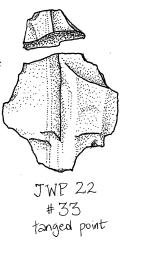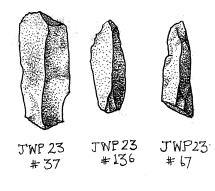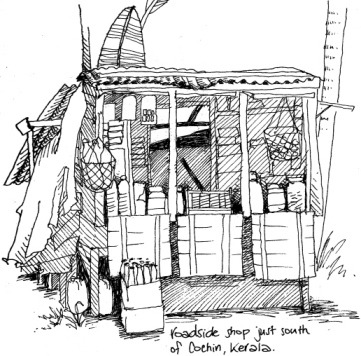The Incredible Human Journey (15 page)
Read The Incredible Human Journey Online
Authors: Alice Roberts

At the moment, the earliest indisputable evidence of modern humans in the Indian subcontinent comes from Sri Lanka, where modern human fossils and microlithic stone tool assemblages have been found at the sites of Fa Hien Cave, dated to about 31,000 years ago, and at Batadomba-lena, at about 29,000 years ago.
4
So Mike and Ravi’s claim is understandably controversial: the dates from Jwalapuram are more than twice as old.

For Mike, the archaeological findings also suggested that modern humans in the area may have survived the fallout from the super-eruption. ‘What’s so exciting is that we are finding tools above and below the ash. The tool types and styles don’t change dramatically.’
This seemed quite remarkable. Some scientists have suggested that the Toba super-eruption would have plunged the planet into a ‘volcanic winter’. Volcanic dust in the atmosphere could have caused an average 5 degree C drop in the temperature of the northern hemisphere, lasting several years. While the earth was already cooling down when Toba blew, the massive eruption may have accelerated the transition into the glacial period of OIS 4, by cooling the world and promoting the growth of northern ice sheets, resulting in more heat being reflected from the earth’s surface.
1
Some geneticists have argued that the pattern of variation in genes across human populations today shows that, around this point in human prehistory, there was an ‘evolutionary bottleneck’: numbers of our species dropped to catastrophically small levels, making us an endangered species for a while.
5
,
6
But other scientists have said this is too extreme a model, and that, while Toba was certainly a massive eruption, spewing out something like 28,000 cubic
kilometres
of lava, its effects on climate may have been more subtle. A more conservative view sees Toba producing a global temperature reduction of 1 degree C, and unlikely to have triggered the last glaciation.
3
But even if Toba did not create significant climatic disruption, the ash fall would undoubtedly have had an impact on human populations.
7

Neither Mike nor Ravi wanted to underplay completely the environmental impact of the eruption, though. ‘There’s no doubt that the Toba super-eruption had an ecological impact: the water would have been poisoned, plants would have been suffering, animals would have been suffering. And the people subsisting on plants and animals would have been affected, of course,’ said Mike. Once the ash had settled, the ancient hunter-gatherers of Jwalapuram would have faced an ecological disaster. With the lake poisoned with volcanic ash, the springs in the limestone escarpments may have provided an essential source of untainted water.
‘But you don’t think it wiped the population out?’ I asked.
‘Well, the Toba super-eruption didn’t seem to have quite the devastating impact it was once thought to have had. The population here didn’t crash, and people continued to live in this area.’
Mike was very careful to say that he couldn’t be sure the tools above the ash were made by
precisely
the same individuals as below the ash, but he still believed that the human population in the general area had survived Toba.
In fact, Mike also thought that the ancient people of Jwalapuram had probably coped better than
we
would if something the size of Toba went off today. ‘Hunter-gatherers were able to perhaps cope with environmental catastrophes in a much better way than settled societies, because they were flexible. They could shift their dietary strategies; they could move on to places that were more desirable. Today, in a sense, we’re trapped. We can’t move. If a super-eruption happened now it would make a massive impact on our societies.’
Although there was general continuity in the tool types at Jwalapuram, it was interesting that the microblades seemed to appear only above the ash. Perhaps they represented humans experimenting with different ways of hunting and surviving in the cooler and drier climate that set in after the Toba eruption. The landscape would have become less wooded and more open; more sophisticated projectile technology may have been a very useful adaptation in this changed environment.
It’s tempting to turn the Toba event into a story of humans triumphing against adversity, using their superior skills and cunning to survive when other, lesser species would have curled up their toes and died. Of course, humans weren’t the only species to suffer the effects of the Toba super-eruption. A recent study of other animals in South-East Asia around the time of the eruption revealed some fairly predictable, but also some quite surprising results. Some species certainly appeared to become extinct following the eruption – but actually relatively few. Most survived it, retreating into refuges that allowed them to bide their time until the worst was over, and then sprang back quite quickly, spreading over large areas of the landscape within a century of the environmental devastation caused by the volcano. It shows how robust mammals can be, and that it wasn’t just humans that bounced back.
8
There were still many questions left to be answered at Jwalapuram, and the Indian stage of the human journey is far from clear. Many palaeoanthropologists remain unconvinced that the tools are evidence of modern human presence at the time of the Toba eruption. But the wider context seems to provide some support for the idea: the ability of the population to survive the Toba devastation and continue producing similar tools; the fact that the Jwalapuram toolkit resembles sub-Saharan MSA assemblages; and the dates also seem to fit the genetic suggestion of an African exodus around 80,000 years ago.
9
There’s no doubt that both Mike and Ravi would love to find some indisputable evidence: remains of modern humans themselves. As Mike put it: ‘That would be like the Eureka moment – a human fossil from this period, in India, would be a major find.’
Ravi had an idea that early modern humans had made their way across India following a chain of lake basins – like Jwalapuram. But there are other possibilities. If indeed the Jwalapuram tools were made by modern humans, this only indicates their existence in that place, and does not negate their presence elsewhere. And Ravi’s transcontinental, basin-hopping route across India flies in the face of the more traditional explanation of the eastwards spread of modern humans out of Africa: along the coasts. Paul Mellars
10
talks about a ‘coastal express route’, with modern human populations fairly nipping along the shores of the Indian Ocean. The genetic evidence certainly suggests modern humans moved quickly eastwards, reaching Malaysia and the Andaman Islands by 55,000 and possibly even 65,000 years ago. But Mellars recognises that a major challenge to this rapid, coastal dispersal is the lack of hard archaeological evidence from India and Arabia. From Mellars’ point of view, Jwalapuram is one of a very few sites of sufficient antiquity that could represent modern humans in India at or close to the ‘colonisation front’. But he does not think that Jwalapuram stands as a challenge to the coastal route – why shouldn’t modern humans be penetrating the interior of the continent as well as moving along the coast? On its own, the site certainly doesn’t prove that there was an east–west, transcontinental route across India, as opposed to a coastal route, and it could even just be a cul-de-sac.
The attraction of the beachcombing, coastal route, in spite of the lack of hard evidence, is that it makes a lot of sense from an ecological standpoint. Attempts to identify the easiest and most likely routes of colonisation, based on the environment of South Asia between 70,000 and 45,000 years ago, have suggested that coastlines would have been ideal (with a secondary route through the Western Ghats, along tributaries of the Krishna River and along the northern border of the Deccan Plateau). There are a few Middle Palaeolithic sites close to the coast of India, but most of them are far too old to be modern human, except for those in the Hiran Valley, with Middle Palaeolithic tools dating to around 60,000 years ago.
11
,
12
It’s very important to remember that sea levels have changed and are much higher today than they were for most of the Pleistocene: the ancient coastline is now beneath the waves. Perhaps the archaeological evidence for these earliest modern human migrations is down there, too.

Hunter-Gatherers and Genes in the Rainforest:
Lenggong, Perak, Malaysia
Moving eastwards, the archaeological record is still very patchy. The same problems that beset my search for evidence in India affect the entire putative route along the northern rim of the Indian Ocean: sea levels have risen, hard fossil evidence is missing, and toolkits are hard to assign to modern humans with any degree of certainty. The next leg of my journey would take me to Malaysia, to rendezvous with Stephen Oppenheimer and the Lanoh people of the Lenggong Valley.
Stephen is a geneticist and a force to be reckoned with in palaeoanthropology. He has published widely in the scientific literature, but also has a strong interest in letting people outside of the illuminati know what’s going on, and has written several popular books on the subject, one of which,
Out of Eden
, I had in my bag as I went to meet him. I knew that Stephen was a medical doctor, and I wanted to know what had got him interested in genetics and, in particular, in early human migrations. I met Stephen in a hotel in Kuala Lumpur, and the following day, as we drove to the Lenggong Valley in the north of peninsular Malaysia, his story started to emerge.
It turned out to be a mixture of curiosity, a wandering spirit and family ties that had drawn Stephen to the Pacific, and genetics. He had studied medicine at Oxford University, spending his clinical years in the Royal London (teaching) Hospital, where he had stayed on for his first job as a junior doctor. But a year later – as soon as he was a fully registered doctor, wanderlust had got the better of him. ‘Within a week of finishing those jobs and getting registration, I headed off out east – to Hong Kong in the first place, where I worked in a mission hospital for a few months. From Hong Kong I went to Bangkok, and then I worked as a flying doctor in Borneo.’
After a year in the Far East, Stephen returned to England for three years, to specialise in paediatrics. Then he hurried back east, this time to work as a paediatrician in Papua New Guinea. I asked him how he became interested in genetics. ‘After getting more clinical experience, I started doing research in New Guinea,’ recounted Stephen. ‘I was interested in iron deficiency anaemia – its causes and prevention. And at that time I noticed that there was a very high rate of a genetic blood disorder which also causes anaemia: α-thalassaemia.’
In fact, this disorder was
so
common in these South-East Asian populations that Stephen had actually found the highest rate of any genetic defect, anywhere in the world. He also knew that another genetic form of anaemia, sickle cell anaemia, was very high in African populations. And the reason for this was well known: although the genetic ‘defect’ caused anaemia, it was also protective against malaria.
